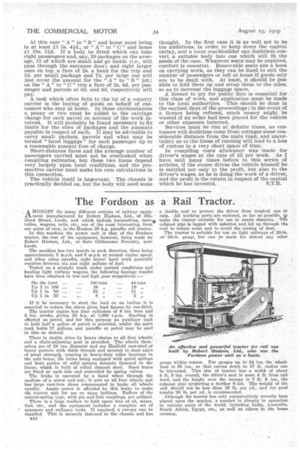The Fordson as a Rail• Tractor.
Page 26

If you've noticed an error in this article please click here to report it so we can fix it.
, A NIONGST the many different articles of railway equipment manufactured by Robert Hudson, Ltd., of 38a, Bond Street, Leeds, and which include locomotives, turn-it tables, wagons, rails, etc., one of the most interesting, from our point of view, is the Hudson 20 h.p. paraffin rail tractor. In this machine the power unit is that of the Fordson tractor, the rest of the equipment, however, being made by Robert Hudson, Ltd., at their Gildersome Foundry, near Leeds.
The machine has two speeds in each direction, these being approximately 3 m.p.h. and 8 m.p.h. at normal engine speed, and when using paraffin, eight hours' hard work generally requires between six and eight gallons of fuel.
Tested on a straight track under normal conditions and hauling light railway wagons, the following haulage results have been obtained in low and high gear respectively:— If it be necessary to start the load on an incline it is essential to reduce the above given load figures by one-third.
The tractor engine has four cylinders of 4 ins. bore and 5 ins, stroke, giving 20 h.p. at 1,000 r.p.m. Starting is effected on petrol, and for this pnrpose an auxiliary tank to hold half a gallon of petrol is provided, whilst the main tank holds 17 gallons, and paraffin or petrol may be used in this as desired.
There is double drive by heavy chains to all four wheels. and a chain-adjusting gear is provided. The wheels themselves are of 24 ins. diametdr and are Hadfield cast-steel of heavy pattern with thick threads and secured to steel axles of great strength, running in heavy-duty roller bearings in the axle boxes, the latter being equipped with spiral springs and horn guides of solid pattern securely fastened to the frame, which is built of rolled channel steel. Sand boxes are fitted at each side and controlled by spring valves.
The brake is operated by a hand wheel through the medium of a screw and nut; it acts on all four wheels and has large cast-iron shoes compensated to brake all wheels equally. Ample power is afforded by this brake to make the tractor safe for use on steep inclines. Buffers of the central-spring type, with pin and link couplings, are utilized.
There is a large toolbox to hold spare tins of oil, water, fuel, etc., and the equipment includes a complete set of spanners and ordinary tools. If required, a canopy can be supplied This is securely fastened to the chassis and has B44
a double roof to protect the driver from tropical sun or rain. All working parts are enclosed, so far as possible, tp make the tractor suitable for use in sandy districts. The exhaust pipe is lagged with asbestos and led up through gas roof to reduce noise and to avoid the raising of dust.
The tractor is suitable for use on light railways of 20-in. or 24-in, gauge, but can be made for almost any other
gauge within reason. For gauges up to 24 ins, the wheelbase is 36 ins., so that curves down to 87 ft. radius can• be traversed. This size of tractor has a width of about 4 ft. 8 ins, overall, the driver's seat is some 4 ft. from rail level, and the height over the canopy is 7 ft. 6 ins., the exhaust pipe projecting a further 6 ins. The weight of the rail should not be less than 16 lb. per yd., and for good results 20 lb. per yd. is recommended.
Although the tractor has only comparatively recently been placed upon the market, a number is already in operation in various parts of the world, including India, Australia, South Africa, Egypt, etc., as well as others in the home country.




























